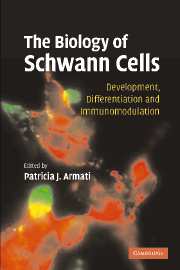Book contents
- Frontmatter
- Contents
- Preface
- Contributors
- 1 Introduction to the Schwann cell
- 2 Early events in Schwann cell development
- 3 The molecular organisation of myelinating Schwann cells
- 4 The role of the extracellular matrix in Schwann cell development and myelination
- 5 The biology of perisynaptic (terminal) Schwann cells
- 6 Cytokine and chemokine interactions with Schwann cells: the neuroimmunology of Schwann cells
- 7 Schwann cells as immunomodulatory cells
- 8 Mutations in Schwann cell genes causing inherited neuropathies
- 9 Guillain–Barré syndrome and the Schwann cell
- 10 Chronic idiopathic demyelinating polyneuropathy and Schwann cells
- References
- Index
- Plate section
6 - Cytokine and chemokine interactions with Schwann cells: the neuroimmunology of Schwann cells
Published online by Cambridge University Press: 13 August 2009
- Frontmatter
- Contents
- Preface
- Contributors
- 1 Introduction to the Schwann cell
- 2 Early events in Schwann cell development
- 3 The molecular organisation of myelinating Schwann cells
- 4 The role of the extracellular matrix in Schwann cell development and myelination
- 5 The biology of perisynaptic (terminal) Schwann cells
- 6 Cytokine and chemokine interactions with Schwann cells: the neuroimmunology of Schwann cells
- 7 Schwann cells as immunomodulatory cells
- 8 Mutations in Schwann cell genes causing inherited neuropathies
- 9 Guillain–Barré syndrome and the Schwann cell
- 10 Chronic idiopathic demyelinating polyneuropathy and Schwann cells
- References
- Index
- Plate section
Summary
INTRODUCTION
Cytokines, first described as products of the cells of the inflammatory/immune system, are increasingly recognised as acting on non-inflammatory cells as well as being produced by non-inflammatory cells. Nowhere is this more apparent than with cells of the peripheral (PNS) and central (CNS) nervous systems. Studies have clearly indicated that neuroglial cells are targets of cytokines produced by infiltrating immune/inflammatory cells in inflammatory diseases of the PNS and CNS, and are not simply passive targets of lytic destructive processes. In addition there is evidence to show that neuroglial cells, in particular astrocytes, Schwann cells and microglia (cells of the monocyte/macrophage lineage), respond to cytokines by changes in function and phenotype and can themselves produce many of the classically described inflammatory cell cytokines. Perhaps even more interesting are recent studies showing that such cytokines, particularly when produced by cells that are endogenous to the PNS and CNS, are important in PNS and CNS development and perhaps in protection and regeneration of the PNS and CNS in inflammatory, traumatic and even some degenerative diseases.
We and others have been interested in the interactions of Schwann cells and cytokines in the pathogenesis of diseases, modulation and recovery from disease, and regeneration, as well as in normal PNS development and function. Schwann cell–cytokine interactions can be studied in various ways: examining tissue obtained at different stages of development, and at different phases of experimental and naturally occurring diseases, including human disorders of the PNS, and employing different in vitro models.
- Type
- Chapter
- Information
- The Biology of Schwann CellsDevelopment, Differentiation and Immunomodulation, pp. 100 - 117Publisher: Cambridge University PressPrint publication year: 2007
- 2
- Cited by



